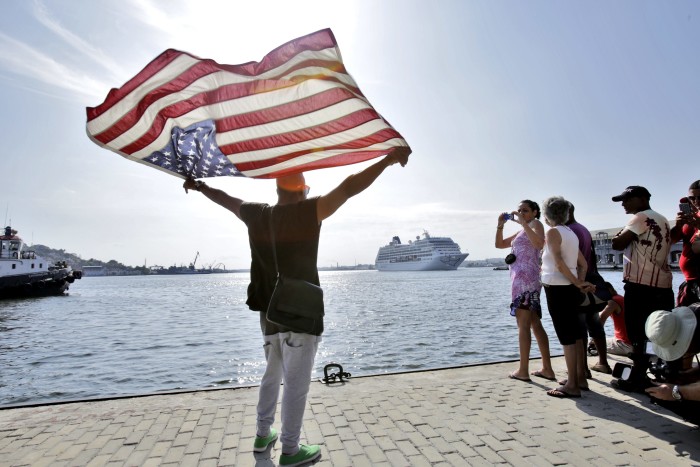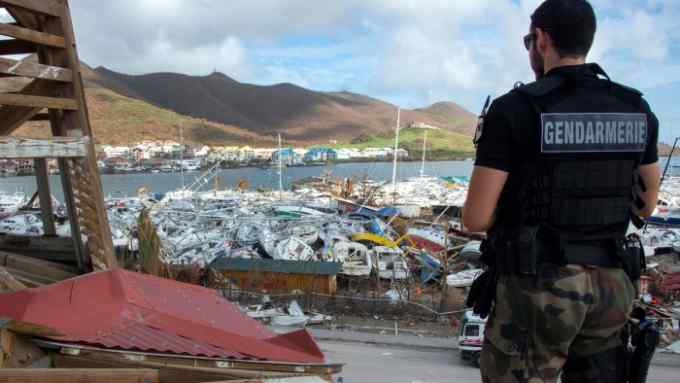US boat owners plot fresh course to Cuba

Roula Khalaf, Editor of the FT, selects her favourite stories in this weekly newsletter.
It used to be that only salty sea-dogs made it to Cuba — or luxury yachters who smuggled themselves in from the Turks and Caicos or Cayman Islands under the radar of the US embargo.
Not any more. Now, in Miami, Fort Lauderdale and Key West — the main departure points for US cruises to Cuba — tourists can watch the ships arriving from and leaving for the island.
Socialist Cuba is the new hot destination for cruising, be that in a chartered yacht or cruise ship. It is now a common sight to see a giant cruise ship gliding into the Havana bay, or a plush yacht docking in the Marina Hemingway across town. The St Petersburg (Florida) to Havana regatta, a fixture from pre-revolutionary days, has returned. Boat International Magazine has given a glamorous write-up to Cuba’s magnificent waters, unspoilt reefs, culture and architecture. The biggest attraction for most first-time visitors, though, is the exoticism of a communist country opening slowly to the world.
“Cuba today reminds me of Mexico, Turkey or Italy in the 1980s,” says Bob Kercher, a captain with more than 40 years’ experience who commands the 60m luxury cruiser Jamaica Bay, which sailed to Havana in April. “It has the dusty feel of an old Sophia Loren movie . . . or of a place still in its infancy, like a child that you cannot know how it will grow up. It vastly exceeded my expectations.”
US yachters started to gain access in 2015, following President Obama’s decision to roll back some of the Cold War-era restrictions that had turned the mere 90 miles between Cuba and the US into a seemingly transoceanic distance. Although tourism remained forbidden under the embargo, US visitors can now travel under 12 activities allowed by the US Treasury’s Office of Foreign Assets Control, especially the catch-all category of “people-to-people” educational visits. Commercial flights began, so too cruising.

Donald Trump, the US president, has since partially reversed that process of detente. In June he ordered tighter travel rules and banned US citizens from using any tourism facility — such as ports, hotels or restaurants — owned by the Cuban military conglomerate, GAESA. Nonetheless, Mr Trump seemingly carved out exceptions for ports and airports — and, by extension, that means cruise ships and yachts are exempt too. Detailed regulations are expected later this year.
“If that [the port and airport exemption] was not the case, the US would basically shut down all bilateral contact, which would be totally counter-productive,” says Hugo Cancio, a Cuban-American entrepreneur who also acts as government liaison for Norwegian Cruise Line. “The most important part of US-Cuba relations, in my view, is engagement with people. That’s what is transforming minds and hearts in the US, and what Cubans feel about US people too — that they are not the enemy.”
But the prospect of Cuba’s charms can engender a false sense of security. There are the occasionally baroque complications to deal with on arrival. There is also the dense paperwork the US requires to get there. So it is often best take a leaf out of Ernest Hemingway’s novel To Have and Have Not, and seek help. “It would be better alone, anything is better alone, but I don’t think I can handle it alone,” says its hero, Harry Morgan, a fishing boat captain and sometime smuggler, as he contemplates a trip across the Florida Straits.
Specialists such as María Romeu, who runs Concierge Cuba in Fort Lauderdale, can sort out US paperwork — from maritime insurance to the US Coast Guard’s required CG-3300 permit — as well as, more importantly, a bespoke Cuba itinerary compliant with Ofac rules, the sine qua non of any trip.

“Each trip is custom-made, and Cuba is so big the possibilities are almost limitless,” says Ms Romeu, a Cuban-American with deep island roots who, in a former work life, helped bring Cuban musicians such as Carlos Varela to the US. Typically there is a marine element, “where clients might swim with wild dolphins and engage with maritime scientists”, and a land-based part, which might include a private concert in a Havana mansion or meetings with artists.
“Cost is my number one question,” she says. Refuelling alone can cost $20,000. For a luxury yacht with 10-12 guests cruising for 10 days, the price might range from about $3,000 per guest to $7,000. “But that’s with total exclusivity, and is the most extravagant I have ever done.”
One element to consider is the uncomfortable irony of visiting a socialist country, where the average state wage is $20 a month, from the mahogany-clad cabin of a luxury yacht with a private chef. That makes the spirit of any voyage all the more important — a point underlined by José Miguel Díaz Escrich, commodore of Havana’s independent Hemingway International Yacht Club. “We believe in the union of people who love the sea,” says the former Cuban naval officer, who heads the 25-year-old institution. “Every visit or regatta carries a message of friendship.” That is especially so after the ferocious 2017 hurricane season. Although the Marina Hemingway was unscathed, giant storms such as Irma and Maria lashed the island.

Comments